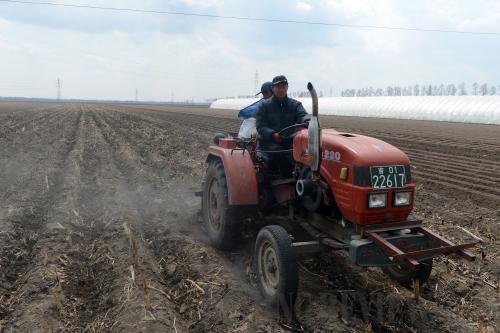|
 |
|
SPRING PLOUGHING Farmers in Nong'an County, northeast China's Jilin Province, fertilize land used for corn crops on April 24 (LIN HONG) |
Manufacturing Activity Slows
China's manufacturing activity lost some of its dynamism in April, a new survey from HSBC indicates, adding to concerns over the recovery of the world's second-largest economy.
The HSBC Flash China Manufacturing Purchasing Managers' Index (PMI) slowed to a two-month low of 50.5 in April, according to figures released by HSBC on April 23.
The bank's preliminary reading for April faltered from March's final index of 51.6. The manufacturing output index also weakened to a two-month low of 51.1, compared with 53.0 in March. A reading above 50 suggests expansion, while a reading below 50 indicates contraction.
Sub-indexes on new export orders and employment dipped into contraction in April, while stocks of finished goods both increased in the month, according to the survey.
For the manufacturing sector, input and output prices both fell at faster rates in April, and there was slower growth in new orders.
"New export orders contracted after a temporary rebound in March, suggesting external demand for China's exporters remains weak," said Hongbin Qu, chief economist for HSBC China. "Weaker overall demand has also started to weigh on employment in the manufacturing sector."
Chinese shares nose-dived over the HSBC PMI data on April 23. The benchmark Shanghai Composite Index dived 2.57 percent, or 57.63 points, to end at 2,184.54, and the Shenzhen Component Index slumped 2.92 percent, or 264.48 points, to 8,793.13.
Tax Reform Pilots
China's Ministry of Finance (MOF) has set up 12 local monitoring offices to study the impact of switching from a business tax to a value-added tax (VAT) on local economies and enterprises.
From early April to the end of 2013, the surveys will monitor at least 10 enterprises in each of the pilot industries, the ministry said.
On April 10, the State Council, China's cabinet, decided to expand its VAT reform to the entire country from August 1. It hopes to complete the reform by the end of 2015.
China introduced the reform in Shanghai last year to avoid double taxation. It was later expanded to another 11 regions, including Beijing and Tianjin, and Shenzhen in south China's Guangdong Province.
By February 1, the program had saved over 1 million taxpayers more than 40 billion yuan ($6.47 billion) in taxes, according to the MOF.
| 